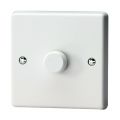Are LED light bulbs any good?
Short version: Yes!

LED light bulb
LED bulbs are great for all types of lighting at home or in the office.
LED lighting works well for everything from general room lighting and outdoor spaces, to effect lighting such as inside a wardrobe, to highlight a shelf display, or mark the edge of the decking in your garden.
In recent years, the technology used in LED lighting has progressed rapidly. We are now happy to recommend that you use LEDs for most of your lighting requirements.
There are still a few cases where the right product just isn't available yet, but this is rare. In general, LEDs are the way to go.
Brightness of LED lighting
In the beginning, LED lights used to be dim, and only really suitable for effect lighting, but that's no longer true.
Modern LED light bulbs can be very bright indeed and are quite suitable to replace an old 100w light bulb. Many manufacturers specify an 'equivalent' wattage, to provide a rough idea of the amount of light produced when compared with an old incandescent light bulb.
Brightness is measured in 'lumen', which is the best way to compare the brightness of one product against another. Comparing wattages is not relevant, as some manufacturers have made more efficient lights by squeezing out more lumen of light for each watt of power consumed.
The technology is constantly improving, so the 'lumen-per-watt' figure is gradually increasing.
'Quality' or colour of light from LED bulbs
The 'quality' of light is a perceptual issue. What we're really referring to is the colour of the light or the mix of colours that make up the colour we can see. Old LED light bulbs earned a poor reputation because they only produced a very specific wavelength of light, which made some objects look great, and others look a bit strange.
Modern LED light bulbs emit a good mix of wavelengths (which determine the colour), just like an old incandescent bulb, so this problem has been resolved. Producing a mix of colours means that objects can be seen as you would expect them to appear.

The same flowers lit by warm, cool and daylight white light
The various wavelengths produced by each LED light bulb can be controlled by the manufacturers, which has resulted in more choice of products. If you prefer a yellow warm white like an old style high energy, incandescent bulb, then that's no problem. Want a cooler 'daylight' light? - no problem either!
The overall colour temperature (shade of white) of light is measured in Kelvin, usually some thousands of Kelvin. The lowest lighting colour temperatures are about 2400K, which is a very warm (yellow/orange) shade of white. The highest commonly used is 6500K, which we describe as 'daylight' and appears more blue than yellow. In the middle is 'cool' white at about 4000K.
Beware that the words used in describing colour temperatures can be misleading as different people use different words for the same thing. e.g. 'daylight white', 'natural white', 'cool white', 'neutral white' have all been used by different manufacturers to describe anything between 3500K and 6500K.
When comparing colour temperatures, it's best to always use the numbers and not the words!
Dimming LED lights
Some LED light bulbs are not compatible with dimmer switches. If a non-dimmable light bulb is connected to a dimmer switch then it's likely that damage to the light bulb will occur.
Even a dimmer switch set to maximum is not the same as a regular on/off switch in the on position.
On the other hand, some LED light bulbs are dimmable, as long as you use a suitable dimmer switch. It's important that a compatible dimmer is used. An old dimmer for incandescent lights will not work with LED lighting.
We recommend the Varilight V-Pro range of dimmers for dimming LEDs. These dimmers are also recommended by most lighting manufacturers as they tend to have the most compatibility with the largest variety of light bulbs.
Enjoyed this article? Tell your friends:
More articles






